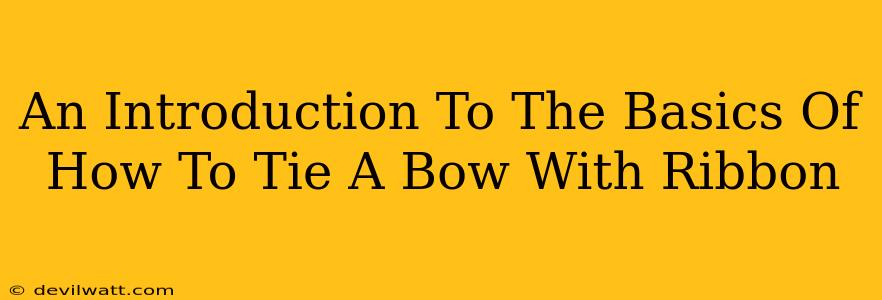So, you're ready to elevate your gift-wrapping game, add a touch of elegance to your crafting projects, or maybe even master the art of the perfect present? Then you've come to the right place! This guide will walk you through the basics of how to tie a bow with ribbon, transforming you from a bow-tying novice to a confident ribbon-bending artist.
Understanding Your Ribbon: The Foundation of a Perfect Bow
Before we dive into the techniques, let's talk ribbon. The type of ribbon you choose significantly impacts the final look of your bow. Consider these factors:
- Material: Satin ribbons offer a sleek, sophisticated finish, while grosgrain ribbons provide a more textured, rustic feel. Organza adds a touch of ethereal beauty. The choice is yours!
- Width: Wider ribbons create bolder, more dramatic bows, while narrower ribbons offer a more delicate, refined look. Experiment to find your preferred width.
- Length: You'll need sufficient ribbon length to create loops and tails of the desired size. Start with a generous length and adjust as needed. A good rule of thumb is to cut a length about 3-4 times longer than the desired final bow size.
The Classic Bow: A Step-by-Step Guide
This method is perfect for beginners and results in a beautifully symmetrical bow.
Step 1: The Cross
Hold your ribbon in both hands, allowing it to drape naturally. Cross the right side over the left, creating an "X".
Step 2: The First Loop
With your left hand, grab the right side of the ribbon just below where it crosses. Create a loop by pulling this section up and through the gap in the X.
Step 3: The Second Loop
Repeat the process, this time grabbing the left side of the ribbon and creating a second loop, mirroring the first. Try to make the loops roughly the same size for a balanced bow.
Step 4: Tying the Knot
You'll now have two loops. Tightly tie the loose ends around the center of the intersecting loops to secure the bow. Adjust loop size and tighten the knot as needed. The more you practice, the more perfect it will become!
Step 5: Shaping and Tailoring
Once the knot is secure, gently adjust the loops to create the desired fullness and shape. Trim the loose ends to achieve a neat, even finish. You can also experiment with different angles and lengths for the tails.
Beyond the Basics: Adding Flair to Your Bows
Now that you've mastered the classic bow, let's explore ways to add some personality:
- Multiple Loops: Try adding extra loops to create a fuller, more luxurious bow.
- Layered Bows: Use two or more ribbons in different colors or widths to create a layered effect.
- Adding embellishments: Incorporate small decorations, such as beads, buttons, or flowers, to personalize your bows.
Practicing Makes Perfect!
Don't be discouraged if your first few attempts aren't flawless. Tying bows is a skill that improves with practice. Experiment with different ribbon types, widths, and techniques to discover your own unique style. Soon you'll be creating stunning bows for all occasions!
With a little patience and practice, you’ll be tying perfect bows in no time! Remember to have fun, and let your creativity shine through. Happy bowing!

